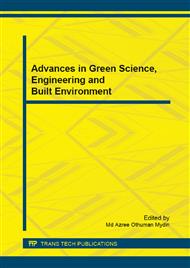p.72
p.76
p.80
p.84
p.88
p.93
p.97
p.101
p.105
The Aspects of Visual Privacy and Interior Design Elements of Malay Dwelling (MD) in Melaka
Abstract:
The Malay Dwelling (MD) is resided by the Malay people, who practices Islam and the Malay cultural values in their daily life. The traditional timber dwelling units consist of the serambi, “middle space”, bedroom, dining, kitchen and bathroom. This dwelling emphasizes on the hierarchy of privacy spaces and visual privacy elements for womenfolk. In Islam, the awrah (modesty) of adult women must be protected from the gaze of non-mahram (blood related) visitors. The space planning demarcations and interior architectural elements are provided to control and regulate visual privacy. It is vital to study women visual privacy because the entire dwelling space is accessible by women. The objective of this paper to study the privacy, space provisions and interior architectural elements that are based by religious beliefs, culture, behavior (adab) and daily social interactions. The research method employs on-site observations, spatial measurements and semi-structured interviews with the dwellers. The result reveals the interior space planning privacy provision and the applications of various architectural elements.
Info:
Periodical:
Pages:
88-92
Citation:
Online since:
March 2015
Authors:
Price:
Сopyright:
© 2015 Trans Tech Publications Ltd. All Rights Reserved
Share:
Citation:


